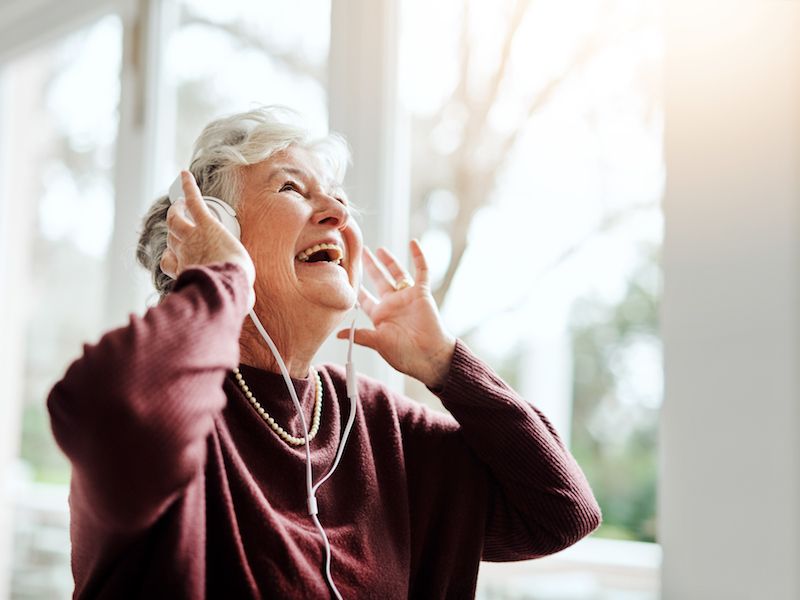
Noise-related loss of hearing doesn’t just impact people who work in loud settings, like construction workers or heavy metal roadies. Leisure related noise exposure can be just as dangerous as work related noise exposure. The most prevalent kind? Loud sounds heard through headphones, whether it’s music, gaming, streaming video, or even an audiobook with the volume turned up.
You may be alarmed to learn that a mobile device can get that loud. But these devices can reach sustained volumes of over 105 dB, which is close to the ordinary human threshold for pain. Your ears will literally start to hurt at this volume. So what’s the plan to protect against this kind of noise-related loss of hearing?
It’s significant here to think about the volume. A quick shorthand that’s widely recommended is the 60/60 rule: Listen with the volume at no more than 60% for 60 minutes or less in a single session (because the length of sound exposure matters, too).
Make a Setting on Your Hearing Aids For Listening to Music
If you wear hearing aids, you’re likely streaming your mobile device directly to your hearing aids, so be sure the volume is not too high or that you’re not attempting to drown out other noises with your music. Additionally, ask us about how best to listen to music. Hearing aids aren’t designed to make music clearer like they do with voices so if you’re really into music, you might have observed this. We might be able to change the configuration to decrease noise and feedback while boosting some frequency ranges to enhance the quality of sound when listening to music.
How to Choose The Right Headphones
If you don’t own hearing aids, there are many choices for shopping for headphones. There are various things to think about, even though it’s largely a matter of personal choice.
Headphones That go Over The Ears
While the foam-covered earpieces that was included with your old Walkman are generally no longer used, over-the-ear headphones have made a comeback. Often shockingly high-priced, they offer a large variety of color possibilities and celebrity endorsements, and yes, superior sound quality. And these headphones go over the whole ear limiting unwanted sound, unlike those old foam ones.
Conventional perception is that these are safer than in-ear headphones because the source of the sound is further away from your eardrum. But the reality is they’re often capable of much louder sound than their smaller kin, the speakers are much larger. Noise cancellation can be a helpful thing as long as you’re not missing useful sounds such as an oncoming car. But on the upside, you don’t have to compete with outside noise so you can enjoy your music at lower levels.
Earbuds
The normal earbuds are widely recognized for poor sound quality, but because they come along with your phone many people still use them. Specifically, with newer Apple devices, it’s just easier to use the earbuds that came with the device because it probably doesn’t have a headphone jack.
The downside, aside from the inferior sound quality, is that basic earbuds can’t cancel outside sounds, so that it’s more likely that you will crank up the sound level. Again, though it’s often said that earbuds are a problem because you put them in your ear so their speakers are extremely close to your eardrum, actually volume is really the biggest issue.
Noise Canceling Earbuds
A lot of people prefer earbuds with a rounded, rubbery tip both because they’re more comfortable than traditional earbuds and more effective at stopping outside noises. A seal that stops outside noise from getting in is formed by the rubber tip which conforms to the shape of the ear. But these earbuds can also block out sounds you need to hear and volume is still the number one concern. And if you wear hearing aids, clearly these won’t work for you.
You may have to test out more than one pair before you find headphones that are right for you. Depending on what you regularly use them for talking on the phone, say, as opposed to listening to music, you’ll have unique acoustic requirements. Enjoying your music at a healthy volume and coming across headphones that help you do that is essential.
Don’t Cut Corners When Dealing With Your Hearing
Is it Safe, How Can I be Sure? There’s an app for that…If you use a smartphone, you can get the National Institute for Occupational Safety and Health’s free Sound Level Meter app. You can get other apps, but research has discovered that the accuracy of these other apps is spotty (also, for reasons yet unknown, Android-based apps have proven less precise). That prompted NIOSH to create their own app. You can measure outside sounds using the app, but you can also measure the sound coming from your device’s speakers, so you will know precisely how much volume your ears are getting. You have to put in a little effort, but putting in place these types of protective steps can help protect your hearing.
